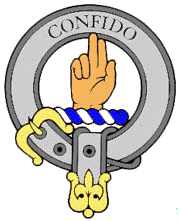


|
History of The City of Kilmarnock
From "The Boyd Family" by Scott Lee Boyd, 1935
The city of Kilmarnock, the original home of the Boyd family in the Old World, is situated a few miles inland upon the western coast of the Highlands of the romantic country called "Scotland." The place today is one of the largest towns in the County of Ayr and rests upon the banks of two mossy streams called Irvin and Kilmarnock, some fifteen and one-half miles by rail northeast of Ayr and twenty-four miles southwest of Glasgow.
Kilmarnock, for a long time after the death of''Marnock," a noted Irish minister or prophet, from whom its name is derived, must have been a mere hamlet. for we find no trace of it in history until the year 1591, when our noble family of Boyds became possessors of the land and made a burgh or barony of it. The earliest mention of it is by Barbour, in his life of Bruce, as one of the chance places through which the English knight, Sir Philip Mowbray, fled, after being defeated by Douglass, somewhere in the District of Cunningham, about the year 1306.
The town books go no farther back than 1686 and throw no light on the general history of the place. The first entry of baptism was recorded for February 6, 1644.
One of the first notices of any consequence which we have of Kilmarnock, is in a document giving the names of persons who voted on appointment of a Parish, or clerk of a Parish, in the year 1507. In the list, the Boyd name appears fifteen times, Smyth sixteen and Brown twenty times.
Kilmarnock was created a burgh or barony in 1591, under the Boyds, and its charter was confirmed by Charles II, in 1672.
There is the following interesting document found among the archives of Scotland today, which is the charter of King James VI to Thomas Boyd and Son, erecting the town of Kilmarnock into a burgh or barony and reads thus:
"Charter and Infertnum by James VI. In favor of Thomas Lord Boyd in Life sent and Robert Master of Boyds in Fee, dated 12 January 1591."
"In witness whereof, etc., witnesses, etc., at Holyrood House, the twelfth day of the month of January, in the year of our Lord MDXCI and of our reign XXV."
(Signed) James VI.
(Space does not permit quoting the lengthy document.)
In the village of Kilmarnock the Boyds erected at this time what was called "Gallows Knowe" for punishment of those who failed to do as they were requested, or were enemies to the will of the Boyds. The structure stood until 1861, when it was torn down. Authority was given, as seen in the above charter, to Lord Thomas Boyd to establish this "Gallows Knowe" in his barony. Dr. Johnson, an able writer on Scottish history, says: "The name so called was in consequence of being the place of execution in the day of feudalism Boyds had at one time the right of pit and gallows, a privilege conferred on all Barons according to our old laws of having on his grounds a pit for drowning women and gallows for hanging men convicted of theft."
On May 22, 1665, the town of Kilmarnock was wholly destroyed by fire. Another large fire visited the place on Saturday, April 26, 1800.
In Burns' time, Kilmarnock enjoyed the reputation of being the most irregularly built town in the west of Scotland.
The Parish of Kilmarnock contains some interesting memorials and relics of grandeur of bygone days. One of these is the very heavy Grown ruins of Dean Castle, the home of the Boyd family for nearly eight hundred years, which was destroyed by fire in 1735.
Dean Castle stands at a distance of nearly a mile northeast of the present site of the City of Kilmarnock. This city now rests upon lands once owned by the noble Family of Boyd, in the County of Ayrshire on the western coast of Scotland. Its situation, in country redolent of history, though not, perhaps, the most romantic, can scarcely fail to delight the admirer of the magnificent in nature.
According to Dr. Jamieson, a noted historian, the name "dean" signifies a small valley or hollow where the ground slopes on both sides. Not far from the castle the scene is enlivened by two little mossy streams locally called the "Borland and Crawfordland".
Francis Grose, one of Scotland's able writers, visited the castle about the year 1789, and made a drawing of its ruins for his "Antiquities of Scotland", from which we quote:
"This is one of the ancient seats of the Boyds. Earls of Kilmarnock, for some time the favourites of King James III. It was forfeited in the year 1745, afterwards sold to the Earl of Glencairn, and in 1789, when this drawing was made, belonged to Miss Scott.
"It lies a small distance from the main road leading from Kilmarnock to Stewarton, and consists of a large vaulted square tower, which seems to have been built about the beginning of the fifteenth century; this is surrounded by a court and other buildings, apparently more modern. Upon the tower under a defaced coat of arms, there is this inscription:
James Lord of
Kilmarnock
Dame Katherine Creyk
Lady Boyd
"The Lord James, here commemorated, according to Douglas, died in 1654. He was a firm adherent to the royal cause, for which he was by Oliver Cromwell exempted from pardon, and fined fifteen hundred pounds sterling. He was the eighth Lord Boyd.
"In this castle, it is said, Lady Margaret (Douglas calls her Mary) sister to King James III, was confined during the life of her husband, Thomas Boyd, Earl of Arran, from whom she was divorced, notwithstanding she had borne him two children. The pretext for this divorce was some legal impediment at the time of their marriage."
The walls of the high tower are about ten feet thick. As a place of strength, as well as a manor-house, the "Dean" appears to have been superior to many of the strongholds of our Scottish barons of older times.
After the burning of Dean Castle, William Boyd, Earl of Kilmarnock, lived at the Marnock house, which is still in existence and is used as an industrial building.
Today Dean Castle is fully restored and is now a museum
and a county park.
|